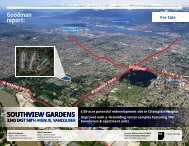Canada
MER-Canada-2016
MER-Canada-2016
You also want an ePaper? Increase the reach of your titles
YUMPU automatically turns print PDFs into web optimized ePapers that Google loves.
EXECUTIVE SUMMARY<br />
funds of designated persons. None of the Canadian authorities has an explicit mandate to monitor<br />
FIs’ and DNFBPs’ implementation of their counter-PF obligations but, in practice, OSFI has examined<br />
implementation by FRFIs of TFS for both TF and PF, and has also identified shortcomings and<br />
requested improvements.<br />
Preventive Measures (Chapter 5 - IO4; R.9-23)<br />
27. AML/CFT requirements are inoperative towards legal counsels, legal firms and Quebec<br />
notaries. These requirements were found to breach the constitutional right to attorney-client<br />
privilege by the Supreme Court of <strong>Canada</strong> on 13 February 2015. In light of these professionals’ key<br />
gatekeeper role, in particular in high-risk sectors and activities such as real-estate transactions and<br />
the formation of corporations and trusts, this constitutes a serious impediment to <strong>Canada</strong>’s efforts to<br />
fight ML.<br />
28. FRFIs, including the six domestic banks that dominate the financial sector, have a good<br />
understanding of their risks and AML/CFT obligations. Supervisory findings on the implementation<br />
of the risk-based approach (RBA) are also generally positive. The large FRFIs conducted<br />
comprehensive group-wide risk assessments and took corresponding mitigating measures. In an<br />
effort to mitigate some of the higher risks, a number of FRFIs have gone beyond the Canadian<br />
requirements (e.g. by collecting information on the quality of AML/CFT supervision in the<br />
respondent bank's country).<br />
29. Nevertheless, some deficiencies in the AML/CFT obligations undermine the effective<br />
detection of very high-risk threats identified in the NRA, such as corruption. This is notably the case<br />
of the current requirements related to politically exposed persons (PEPs). The identification of<br />
beneficial ownership also raises important concerns. Although the legal requirements have recently<br />
been strengthened, little is done by FIs to verify the accuracy of beneficial ownership information.<br />
DNFBPs are not required to identify the beneficial ownership nor to take specific measures with<br />
respect to foreign PEPs.<br />
30. Most DNFBPs are not sufficiently aware of their AML/CFT obligations. This is in particular<br />
the case of real estate agents. Extensive work has been conducted by FINTRAC with relevant DPMS<br />
trade associations, to increase the DNFBPs’ awareness, which is leading to some improvement in<br />
compliance. REs have gradually increased the number of STRs and other threshold-based reports<br />
filed with FINTRAC but reporting remains very low. The fact that no STRs have been filed by<br />
accountants and BC notaries, and the low number of STRs received from the real estate sector raise<br />
concern.<br />
Supervision (Chapter 6 - IO3; R.26-28, R. 34-.35)<br />
31. FINTRAC and OSFI supervise FIs and DNFBPs on a risk-sensitive basis. FINTRAC should,<br />
however, apply more intensive supervisory measures to DNFBPs. There is good supervisory<br />
coverage of FRFIs, but FINTRAC and OSFI need to improve their coordination to share expertise,<br />
maximize the use of the supervisory resources available and avoid duplication of efforts. FINTRAC<br />
has increased its supervisory capacity in recent years. It adopted an effective RBA in its compliance<br />
Anti-money laundering and counter-terrorist financing measures in <strong>Canada</strong> - 2016 © FATF and APG 2016<br />
7




